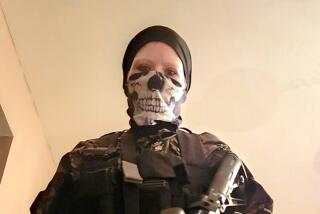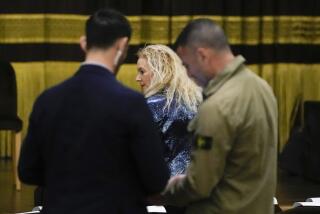Italy Troubled by the Twilight World of Terrorism on the Right
- Share via
ROME — Italy is painfully familiar with left-wing terrorism but now is facing up to an equally dangerous but little-understood phenomenon: terror on the right.
The latest incident for which neo-fascist rightist terrorists have been blamed was the bomb blast aboard Train 904, the Naples-to-Milan express, as it raced through a 12-mile tunnel in the Apennine Mountains between Florence and Bologna on Dec. 23. Fifteen people were killed.
Who are these rightists? Why do they plot such indiscriminate mass killings as the attack on Train 904 and the waiting-room bombing of the Bologna railroad station that took 85 lives in August, 1980? What do they want?
To Italian authorities, the last question is the easiest to answer. The terrorists want a return to rigid and orderly rule by a fascist elite over a nation that the extreme right believes has become hopelessly disorganized and frustrated under democracy. The name of a right-wing terrorist group that surfaced briefly a few years ago is an answer in itself: Mussolini Action Squads.
But in the twilight world of what the Italians call “black terrorism”--as distinguished from the more familiar red variety of the leftist Red Brigades--so little is known that even expert investigators who have spent months searching for subversive rightist groups and interrogating arrested fascist terrorists have had to call on political scientists and sociologists to test the logic of their findings.
For example, two Florence investigative magistrates, Pier Luigi Vigna and Rosario Minna, have spent much of the past year listening to jailed terrorists, some of them eager to cooperate, and compiling masses of information from police files. They then called in a political-social research group headed by Prof. Luigi Pedrazzi of Bologna University to sift the evidence for possible motives behind the bombings.
The Pedrazzi group studied the testimony of imprisoned right-wing terrorists such as Sergio Calore, who was convicted in the 1976 murder of an anti-fascist judge, and two self-proclaimed members of the most famous and most shadowy of the right-wing groups, the Armed Revolutionary Nuclei. The researchers drew a distinct contrast between terror from the left and terror from the right.
“To strike in a crowd has always been a characteristic of black terrorism, as opposed to the left-wing terrorism which has always chosen as its targets discrete symbols,” they said.
The logic of indiscriminate attacks in which dozens of innocent people may die and hundreds may be injured, they said, follows the political logic of fascism, in which “the others” are different from the elite “us,” and therefore are the enemy.
“The ‘others,’ ” they quoted Calore as saying, “are only enemies to quash. In this sense, the massacre represents normalcy in neo-fascist politics. Whether this is accomplished verbally or materially, the aim is to deny those who are different from ‘us’ the right to existence.”
The investigators and social scientists also came up with documentary evidence that disclosed why the right-wing terror groups have appeared to concentrate on bombing trains. Since 1975, at least 10 bombs have been planted on trains running in and out of Florence, four of them on the same line as Train 904. An earlier bombing, in 1974, involved the express train “Italicus” and left 12 dead, also at holiday time, near the tunnel where 904 came to grief.
In sifting through the papers of a convicted right-wing terrorist named Mario Tuti, whose Ordine Nuovo (New Order) is believed to be responsible for some of the worst actions, the investigators found a 30-page document spelling out the strategic value of blowing up Italian trains.
“Italy, like South America, presents the physical and social conditions suitable for the development of revolutionary guerrilla warfare,” the document began. “The national territory is crossed longitudinally by an uninterrupted chain of mountains . . . . It is easy to look to the interruption of rail communications through the two crossings of the Apennines by way of sabotage of bridges, viaducts and tunnels, thus achieving the economic paralysis of the state . . . . “
Another specialist in terrorism, Prof. Sabino Acquaviva of Padua University, said that despite the rightist groups’ appearance of structure and organization, they are small and not well organized.
“They have a less cultural and educated recruiting ground,” Acquaviva said. “The leftist terrorist groups had a strong political and theoretical base, but the rightists have little or no cultural appeal, and for this reason they have made little progress.”
If Acquaviva’s assessment of the membership of the groups is correct, then it would appear from police and Interior Ministry statistics that the authorities have made deep inroads into their ranks. According to the ministry, almost half of the suspected terrorists arrested in 1983 and 1984 (146 out of 317) were neo-fascists.
Despite the government’s insistence that it is doing everything possible to track down the right-wing groups and to find those responsible for their illegal activity, there have been charges of official laxity, even suggestions that some police officials may be in political sympathy with the neo-fascists.
“In the course of the last 15 or 20 years, black terrorism has never been uncovered--neither its authors nor its executioners--except for a few marginal cases,” complained Sen. Ugo Pecchioli, a Communist who is also vice president of the parliamentary Commission For Security. “This means that this type of terrorism has been favored by the cover-up and the connivance of important sectors of public power.”
Pecchioli recalled several incidents of Italian secret service officers, including their chief, being charged with helping the rightists and trying to throw a smoke screen over investigations of the 1980 Bologna railway station bombing. He also cited links between neo-fascist terrorism and the noto rious P-2 (for Propaganda Due) Masonic lodge, said to have been plotting the overthrow of the government and to have included numerous prominent Italian civil and political figures in its ranks.
The goverment of Socialist Prime Minister Bettino Craxi has reacted bitterly to the Communist criticism, insisting that police agencies and the secret service have been purged of officers with fascist leanings and that a major campaign has been mounted against the right-wing terrorists.
But unlike the Red Brigades, which built a rigidly hierarchical structure that was relatively easy to comprehend--and, finally, to attack--the rightists appear to be as amorphous as clouds and just as unpredictable.
The names of groups like the Mussolini Action Squads spring up and disappear quickly. The best known of them, the Armed Revolutionary Nuclei, which was first to claim responsibility for last month’s train bombing, may never have existed as an organized group, according to the Rome-based magazine Espresso. It is thought to have been a name of convenience, used at different times by different cells of fanatics.
The police believe there are three active neo-fascist terrorist groups, Ordine Nuovo (New Order), Avanguardia Nazionale (National Vanguard) and Terza Posizione (Third Position.)
Ordine Nuovo, which plotted the murder of anti-fascist Judge Vittorio Occorsio in 1976, has been quiet since Tuti was imprisoned, according to Espresso.
Avanguardia Nazionale is known to be led by Stefano Delle Chiaie, who is wanted in connection with the Bologna station bombing and is believed to be dealing in drugs in Latin America.
Terza Posizione is believed to be led by two men, Roberto Fiore and Gabriele Adinolfi, who are both thought to be hiding in England.
A worrisome development in recent months, according to the police and judges investigating the neo-fascists, is a rash of robberies that reflect the modus operandi of previous neo-fascist operations. Police say they do not know whether the money is being raised to finance future terrorism or to support collaborators who are in hiding in Italy and abroad.
Just a few days before the bombing of Train 904, Interior Minister Oscar Luigi Scalfaro described the rightists as “a real danger” and added that 76 known fascist terrorists were being sought. Many are in hiding in Italy, but nine are known to be in Britain, five in Spain and two in Paraguay, he said.
About 400 right-wing terrorists are in jail, according to the police, along with more than 1,600 leftist terrorists. Like many of the Red Brigades terrorists who were swept up after the kidnaping three years ago of U.S. Brig. Gen. James L. Dozier, some of the rightists have turned “penitent” and are cooper ating with authorities in exchange for lighter sentences.
But success in dealing with right-wing terrorism may be as elusive as it has been with regard to the Red Brigades, who despite their setbacks continue to strike. Only Wednesday, they claimed responsibility for another killing, that of a 23-year-old anti-terrorist policeman named Ottavio Conte.
In a gloomy comment, Public Prosecutor Giuseppe Tamburrano said, “Today, unfortunately, I have to note that in very recent times terrorism of every stamp has reap peared in most fearful form.”
More to Read
Sign up for Essential California
The most important California stories and recommendations in your inbox every morning.
You may occasionally receive promotional content from the Los Angeles Times.










